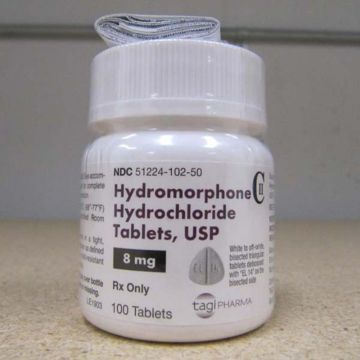Hydromorphone: Uses, Side Effects, Abuse, Addiction

Hydromorphone, also known as dihydromorphinone, and sold under the brand name Dilaudid among others is in a class of medications called opiate (narcotic) analgesics. It works by changing the way the brain and nervous system respond to pain. Hydromorphone is used to relieve pain. Hydromorphone extended-release tablets are used to relieve severe pain in people who are expected to need pain medication around the clock for a long time and who cannot be treated with other medications. Hydromorphone is a Schedule II drug under the Controlled Substances Act with an accepted medical use as a pain reliever. Hydromorphone has a high potential for abuse and use may lead to severe psychological or physical dependence.
Hydromorphone extended-release tablets should only be used to treat people who are tolerant (used to the effects of the medication) to opioid medications because they have taken this type of medication for at least one week and should not be used to treat mild or moderate pain, short-term pain, pain after an operation or medical or dental procedure, or pain that can be controlled by medication that is taken as needed.
How quickly does hydromorphone work?
Hydromorphone onset of action of hydromorphone depends on the route of administration:
1. Intravenous (IV) Administration: When hydromorphone is administered intravenously, it typically has a rapid onset of action. The effects can be felt within minutes, with peak analgesic effects occurring within 15 to 30 minutes.
2. Intramuscular (IM) Administration: When hydromorphone is injected into a muscle, the onset of action is slightly slower compared to IV administration. It usually takes around 15 to 30 minutes for the medication to start working.
3. Oral Administration: Hydromorphone tablets or capsules taken orally have a slower onset of action compared to injectable forms. After oral ingestion, it may take approximately 30 minutes to 1 hour for the effects to be noticeable.
It’s important to note that individual responses to hydromorphone may vary. Factors such as an individual’s metabolism, tolerance, and the presence of other medications or medical conditions can influence the onset and duration of the drug’s effects. It is crucial to follow the prescribed dosage and guidelines provided by a healthcare professional when taking hydromorphone or any other medication.
How should hydromorphone be used?
Hydromorphone comes as a liquid, a tablet, and an extended-release (long-acting) tablet to take by mouth. The liquid is usually taken every 3 to 6 hours and the tablets are usually taken every 4 to 6 hours. The extended-release tablets are taken once daily with or without food. Take hydromorphone at around the same time(s) every day. Follow the directions on your prescription label carefully, and ask your doctor or pharmacist to explain any part you do not understand. Take hydromorphone exactly as directed.
Do not allow the hydromorphone liquid to touch your skin or clothing. If such contact occurs, remove any clothes exposed to the oral liquid and wash your skin thoroughly with cool water.
Your doctor may start you on a low dose of hydromorphone and gradually increase your dose, not more often than once every 3 to 4 days. Your doctor may decrease your dose if you experience side effects. Tell your doctor if you feel that your pain is not controlled or if you experience side effects during your treatment with hydromorphone. Do not change the dose of your medication without talking to your doctor.
Do not stop taking hydromorphone without talking to your doctor. Your doctor will probably decrease your dose gradually. If you suddenly stop taking hydromorphone, you may experience withdrawal symptoms including restlessness, teary eyes, runny nose, yawning, sweating, chills, hair standing on end, muscle or joint pain, widening of the pupils (black circles in the middle of the eyes), irritability, anxiety, backache, weakness, stomach cramps, difficulty falling asleep or staying asleep, nausea, loss of appetite, vomiting, diarrhea, fast breathing, or fast heartbeat. Your doctor will probably decrease your dose gradually. If you do not take hydromorphone extended-release tablets for longer than 3 days for any reason, talk to your doctor before you start taking the medication again.
What side effects can this medication cause?
Hydromorphone may cause side effects. Tell your doctor if any of these symptoms are severe or do not go away:
- headache
- difficulty falling asleep or staying asleep
- dry mouth
- lightheadedness
- drowsiness
- heavy sweating
- muscle, back or joint pain
- stomach pain
- anxiety
- flushing
- itching
- depression
Some side effects can be serious. If you experience any of these symptoms call your doctor immediately or get emergency medical treatment:
- rash
- hives
- swelling of the eyes, face, lips, tongue, mouth, throat, arms, hands, feet, ankles, or lower legs
- difficulty breathing or swallowing
- hoarseness
- agitation, hallucinations (seeing things or hearing voices that do not exist), fever, sweating, confusion, fast heartbeat, shivering, severe muscle stiffness or twitching, loss of coordination, nausea, vomiting, or diarrhea
- nausea, vomiting, loss of appetite, weakness, or dizziness
- inability to get or keep an erection
- irregular menstruation
- decreased sexual desire
- seizures
- chest pain
- extreme drowsiness
- fainting
- lightheadedness when changing positions
Hydromorphone may cause other side effects. Call your doctor if you have any unusual problems while you are taking this medication.
Hydromorphone Safety Information
Hydromorphone may be habit-forming, especially with prolonged use. Take hydromorphone exactly as directed. Do not take more of it, take it more often, or take it in a different way than directed by your doctor. While you are taking hydromorphone, discuss with your healthcare provider your pain treatment goals, length of treatment, and other ways to manage your pain. Tell your doctor if you or anyone in your family drinks or has ever drunk large amounts of alcohol, uses or has ever used street drugs, or has overused prescription medications, or has had an overdose, or if you have or have ever had depression or another mental illness. There is a greater risk that you will overuse hydromorphone if you have or have ever had any of these conditions. Talk to your healthcare provider immediately and ask for guidance if you think that you have an opioid addiction or call the U.S. Substance Abuse and Mental Health Services Administration (SAMHSA) National Helpline at 1-800-662-HELP.
Hydromorphone may cause serious or life-threatening breathing problems, especially during the first 24 to 72 hours of your treatment and any time your dose is increased. Your doctor will monitor you carefully during your treatment. Tell your doctor if you have slowed breathing or have or have ever had asthma. Your doctor will probably tell you not to take hydromorphone. Also tell your doctor if you have or have ever had lung disease such as chronic obstructive pulmonary disease (a group of diseases that affect the lungs and airways), a head injury, a brain tumor, or any condition that increases the pressure in your brain, or kyphoscoliosis (curving of the spine that may cause breathing problems). The risk that you will develop breathing problems may be higher if you are an older adult, or are weakened or malnourished due to disease. If you experience any of the following symptoms, call your doctor immediately or get emergency medical treatment: slowed breathing, long pauses between breaths, or shortness of breath.
Taking certain medications during your treatment with hydromorphone may increase the risk that you will develop serious or life-threatening breathing problems, sedation, or coma. Tell your doctor if you are taking or plan to take any of the following medications: benzodiazepines such as alprazolam (Xanax), chlordiazepoxide (Librium), clonazepam (Klonopin), diazepam (Diastat, Valium), estazolam, flurazepam, lorazepam (Ativan), oxazepam, temazepam (Restoril), and triazolam (Halcion); medications for mental illness or nausea; muscle relaxants; other narcotic pain medications; sedatives; sleeping pills; or tranquilizers. Your doctor may need to change the doses of your medications and will monitor you carefully. If you use hydromorphone with any of these medications and you develop any of the following symptoms, call your doctor immediately or seek emergency medical care: unusual dizziness, lightheadedness, extreme sleepiness, slowed or difficult breathing, or unresponsiveness. Be sure that your caregiver or family members know which symptoms may be serious so they can call the doctor or emergency medical care if you are unable to seek treatment on your own.
Drinking alcohol, taking prescription or nonprescription medications that contain alcohol, or using street drugs during your treatment with hydromorphone increases the risk that you will experience serious, life-threatening side effects. Do not drink alcohol, take prescription or nonprescription medications that contain alcohol, or use street drugs during your treatment.
Swallow the extended-release tablets whole. Do not split, chew, dissolve, or crush them. If you swallow broken, chewed, crushed, or dissolved tablets you may receive too much hydromorphone at once instead of receiving the medication slowly over time. This may cause serious breathing problems or death.
Do not allow anyone else to take your medication. Hydromorphone may harm or cause death to other people who take your medication, especially children. Keep hydromorphone in a safe place so that no one else can take it accidentally or on purpose. Be especially careful to keep hydromorphone out of the reach of children. Keep track of how many tablets or how much liquid is left so you will know if any medication is missing. Dispose of unwanted or no longer needed tablets, extended-release tablets, and liquid by flushing the medication down the toilet.
Tell your doctor if you are pregnant or plan to become pregnant. If you take hydromorphone regularly during your pregnancy, your baby may experience life-threatening withdrawal symptoms after birth. Tell your baby’s doctor right away if your baby experiences any of the following symptoms: irritability, hyperactivity, abnormal sleep, high-pitched cry, uncontrollable shaking of a part of the body, vomiting, diarrhea, or failure to gain weight.
Your doctor or pharmacist will give you the manufacturer’s patient information sheet (Medication Guide) when you begin your treatment with hydromorphone and each time you fill your prescription. Read the information carefully and ask your doctor or pharmacist if you have any questions. You can also visit the Food and Drug Administration (FDA) website.
How to overcome hydromorphone abuse
Overcoming hydromorphone abuse can be a challenging process, but with the right support and treatment, it is possible. Here are some steps you can take:
1. Acknowledge the problem: Recognize and accept that you have a hydromorphone abuse issue. Admitting the problem is the first step toward recovery.
2. Seek professional help: Consult with a healthcare professional, such as a doctor or addiction specialist, who can provide guidance and support. They can assess your situation, recommend appropriate treatment options, and create a personalized plan for recovery.
3. Detoxification: If you have developed physical dependence on hydromorphone, a medically supervised detoxification may be necessary. This process helps manage withdrawal symptoms and ensures your safety and comfort during the withdrawal phase.
4. Therapy and counseling: Engage in therapy or counseling sessions, such as cognitive-behavioral therapy (CBT) or motivational interviewing. These approaches can help you understand the underlying causes of your addiction, develop healthier coping mechanisms, and prevent relapse.
5. Support groups: Consider joining support groups, such as Narcotics Anonymous (NA), where you can connect with others who have faced similar challenges. Support groups provide a sense of community, encouragement, and a platform for sharing experiences and strategies for recovery.
6. Medication-assisted treatment: In some cases, medication-assisted treatment (MAT) may be recommended. MAT involves using medications like buprenorphine or methadone, combined with counseling and behavioral therapies, to help reduce cravings and stabilize your recovery.
7. Lifestyle changes: Make positive changes in your lifestyle to support your recovery. This may include adopting a healthy diet, engaging in regular exercise, practicing stress-reduction techniques (e.g., meditation, yoga), and finding new hobbies or activities to replace drug use.
8. Build a support network: Surround yourself with supportive and understanding individuals who can encourage your recovery journey. This may involve mending relationships with loved ones or seeking out new friendships with people who are committed to a drug-free lifestyle.
Remember, overcoming hydromorphone abuse takes time and commitment. It is important to reach out for help, stay motivated, and be patient with yourself during the recovery process.




